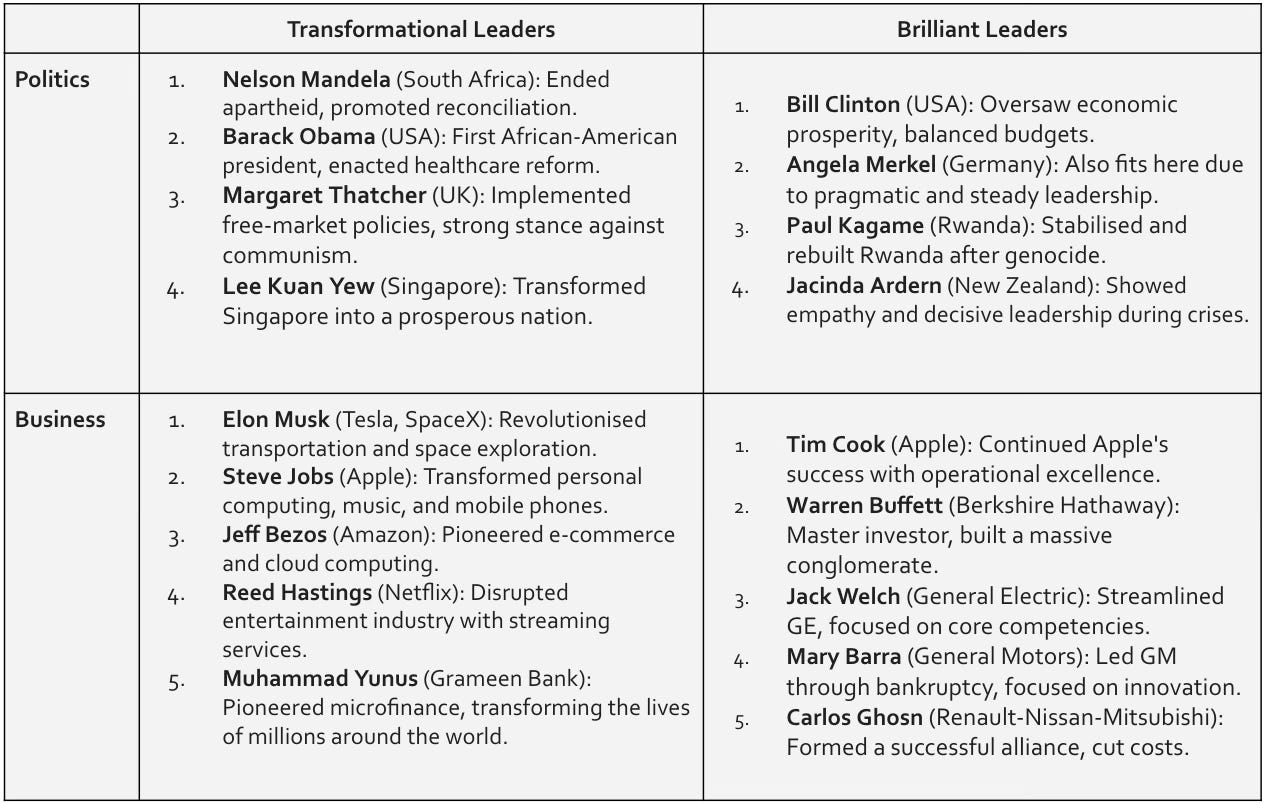"Chaos isn't a pit. Chaos is a ladder." – Petyr "Littlefinger" Baelish, the cunning strategist of Westeros in the hit TV Drama Game of Thrones (2011-2019), understood a fascinating truth about leadership that resonated beyond the fictional realm of kings and queens. In the real world of business and politics, where there are far more factors at play, the ability to not just survive but thrive is the defining characteristic of exceptional leaders. This is where the dichotomy of transformational and brilliant leadership comes into play, a dynamic dance between vision and execution, revolution and optimisation. In his seminal work “Good to Great” Jim Collins highlights the critical role Leadership plays in creating great enduring organisations.
Transformational Leadership: Pioneers of New Frontiers
Transformational leaders often exhibit several important traits. They possess a clear and compelling vision of the future, inspiring others to strive towards ambitious goals. They are charismatic and passionate, able to communicate their ideas effectively and rally support. These leaders challenge the status quo, encouraging innovation and calculated risk-taking. They foster a supportive and empowering environment, recognising and developing the talents of their team members. Transformational leaders are not merely managers; they are architects of a new reality. They possess a rare alchemy of vision, charisma, and an unyielding belief in the potential of their teams. These leaders don't just navigate change; they create it, inspiring those around them to reach for audacious goals that once seemed impossible.
In the United Kingdom, Boris Johnson's tenure as Prime Minister was marked by his transformational leadership in getting Brexit done, a monumental shift in the country's political and economic landscape. Johnson's charisma, optimism, and unwavering commitment to his vision galvanised support of the British people and ultimately led to the UK's departure from the European Union, its Single Market and its various treaties.
At Microsoft, Satya Nadella's transformational leadership revitalised a company that had become complacent and stagnant under the brilliant but more operationally focused Steve Ballmer. Nadella's vision for a "mobile-first, cloud-first" world, coupled with his emphasis on cultural change and employee empowerment, propelled Microsoft back to the forefront of the technology industry. His leadership demonstrates the power of transformation to reinvigorate a company and chart a new course for growth.
In American history, the contrast between transformational and brilliant leadership is evident in the presidencies of Franklin D. Roosevelt and Dwight D. Eisenhower. Roosevelt, a transformational leader, guided the nation through the Great Depression and World War II with his New Deal policies and wartime leadership. His ability to inspire hope and mobilise the country in times of crisis is a testament to the power of transformational leadership. Eisenhower, on the other hand, was a brilliant leader who excelled at execution and consolidation. His steady hand and focus on stability and prosperity helped solidify America's position as a global superpower in the post-war era.
Typical Strengths and Weaknesses of Transformational Leaders
We have already mentioned how Transformational leaders excel at articulating a compelling vision and inspiring others to achieve it. Their charisma and passion can galvanise teams and organisations. However, their visionary focus can sometimes lead to overlooking operational details or neglecting short-term goals. Additionally, their strong personalities can occasionally become overbearing, potentially stifling dissent or alternative viewpoints. Despite these potential drawbacks, the ability of transformational leaders to drive significant change and innovation makes them invaluable assets in today's dynamic business and political landscapes.
Brilliant Leadership: Masters of Execution and Optimisation
If transformational leaders are the architects of the future, brilliant leaders are the master craftsmen who bring those visions to life. They are the pragmatists, the meticulous planners, the ones who ensure that the trains run on time, and the rockets don't just launch, but land safely back on Earth.
The aftermath of Brexit brought its own set of challenges, requiring a different kind of leadership - one Boris was seemingly not suited for. Rishi Sunak, Prime Minister after Liz Truss’ tumultuous and short lived premiership, embodied brilliant leadership, focusing on stabilising the economy, rebuilding trust in government, and steering the country through a period of recovery and adjustment. At Apple, Tim Cook, may not possess the same enigmatic aura as his predecessor, Steve Jobs, but his quiet brilliance is undeniable. He has transformed Apple into a well-oiled machine, a model of operational excellence that consistently delivers innovative products and exceptional financial results. His leadership is a testament to the power of meticulous execution and relentless focus on customer satisfaction.
In the financial sector, Jamie Dimon, CEO of JPMorgan Chase, has consistently demonstrated his brilliance in navigating complex financial markets and steering his organisation through numerous economic crises. Dimon's emphasis on risk management, operational efficiency, and customer service has earned JPMorgan Chase a reputation as one of the most stable and well-managed financial institutions in the world.
Typical Strengths and Weaknesses of Brilliant Leaders
Brilliant leaders excel at operational efficiency, problem-solving, and achieving short-term goals. Their attention to detail and focus on execution ensures that strategies are implemented effectively and organisations run smoothly. However, their pragmatism can sometimes lead to a lack of visionary thinking or resistance to change. Additionally, their emphasis on efficiency can occasionally stifle creativity or innovation. Despite these potential drawbacks, the ability of brilliant leaders to deliver results and maintain stability makes them essential for long-term success.
Are you Transformational, Brilliant or Both?
Transformational and Brilliant leadership do not need to be mutually exclusive. Indeed they are not. Instead, they are complementary forces that must be properly harnessed and skillfully balanced. Like the ebb and flow of tides, leadership requires a dynamic interplay between these two styles. There is time for everything - Brilliant or Transformational. During periods of rapid change or uncertainty, transformational leadership is essential to inspire and guide organisations through turbulent waters. However, once a new course has been set, brilliant leadership is critical to ensure that the vision is translated into tangible results, and the team is aligned working effectively for the greater long term good. The ability to navigate this pendulum, to know when to push for transformation and when to focus on execution, is the hallmark of a truly great leader.
Building for the Future
Great leaders, whether transformational or brilliant, or a blend of both, leave a lasting legacy. They build organisations that can evolve and adapt while maintaining a strong foundation of excellence. They inspire and empower their teams, fostering a culture of innovation and continuous improvement.
Ultimately, they leave the world a better place than they found it. Their impact is undeniable, their vision enduring. As we navigate the complexities of the 21st century, the ability to balance transformation and brilliance will be the defining characteristic of the leaders who shape our future.





